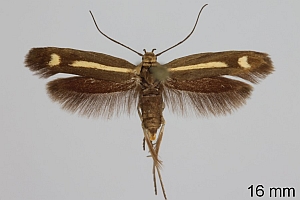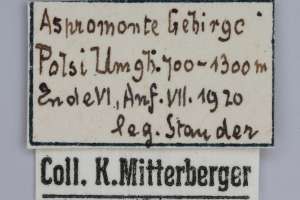Länder:

 +3Kontinente:EU
+3Kontinente:EU


 +3Kontinente:EU
+3Kontinente:EUNeues Layout der Navigation (Beta Test)
LebendfotosFalterDiagnoseBiologieNahrung der RaupeWeitere InformationenEtymologie (Namenserklärung)TypenmaterialLiteraturInformationen auf anderen Websites (externe Links)
4. Weitere Informationen
4.1. Etymologie (Namenserklärung)
Die Art ist nach dem Aspromonte-Gebirge benannt, in dem ihr locus typicus liegt.
4.2. Typenmaterial
Jäckh (1978: 75): „Holotypus ♂: „Aspromonte Gebirge, Monte Alto 1900, 29. VI. 1920, leg. Stauder“ in Coll. Oberösterr. Landesmus. Linz, Präp. Jä 8239. (Mitterberger (1925) bestimmte 12 von Stauder gefangene Falter als Scythris ossianella Mill.)
Paratypen: 12 Falter aus dem Aspromonte-Gebirge, davon 6 von Stauder in der Umgebung von Polsi gefangen, Präp. Jä 8566 ♂, Jä 9208 ♂, Jä 8565 ♀, Jä 8587 ♀ in Coll. Oberösterr. Landesmus. Linz und 6 Stück aus der Umgebung von Gambarie, 1300 m, 15. VII. 1970 und 29. VII. 1971, leg. Hartig, Präp. Jä 7543 ♂ und Jä 7556 ♀ in Coll. Ent. Inst. Bozen und Coll. Jäckh.“
4.3. Literatur
- Erstbeschreibung: Jäckh, E. (1978): Bearbeitung der Gattung Scythris Hübner (Lepidoptera, Scythrididae) (Fortsetzung). — Deutsche Entomologische Zeitschrift, Neue Folge 25 (1-3): 71-89. Berlin (Akademie-Verlag) [Digitalisat und PDF-Download auf onlinelibrary.wiley.com].







